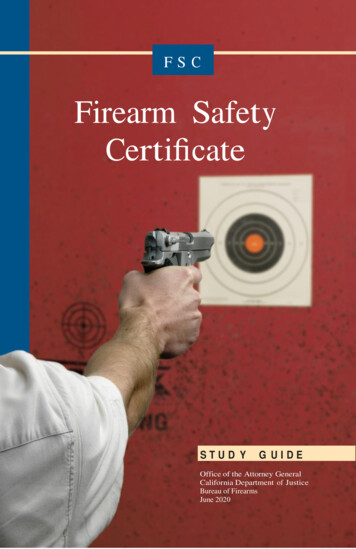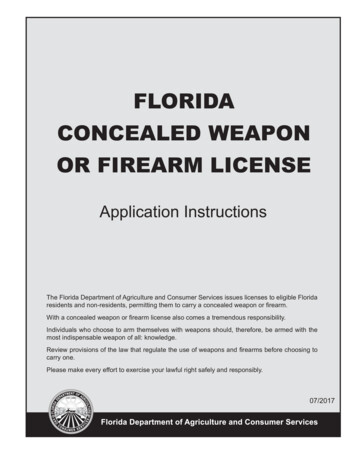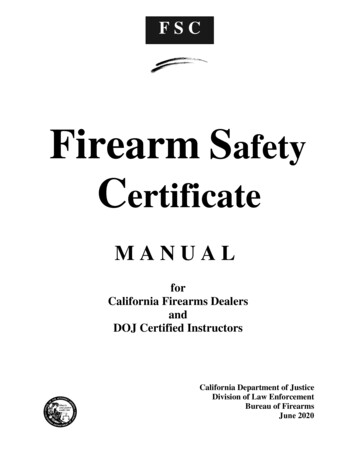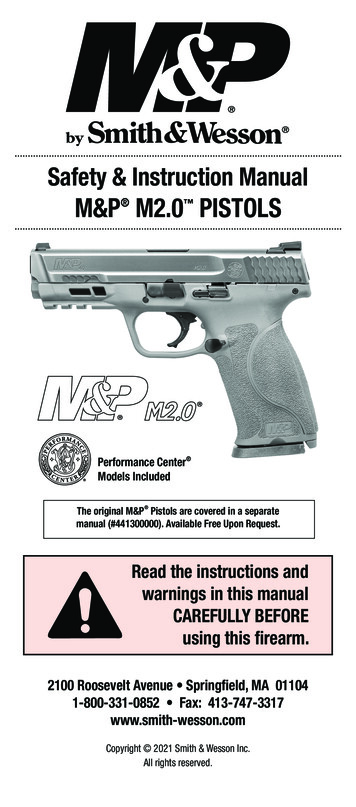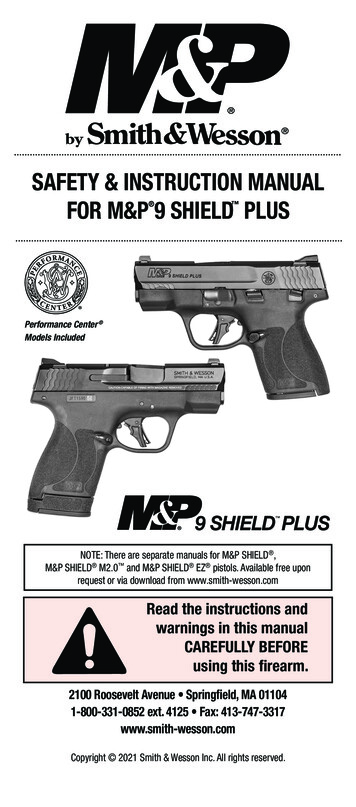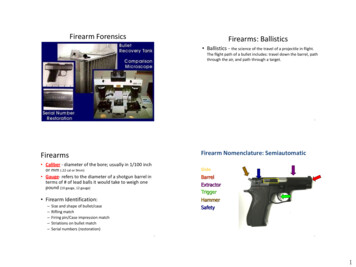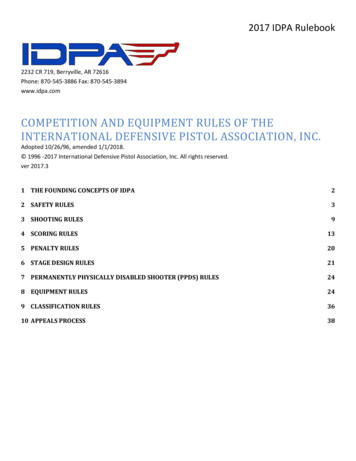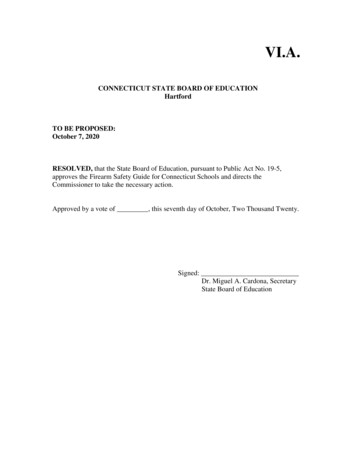
Transcription
VI.A.CONNECTICUT STATE BOARD OF EDUCATIONHartfordTO BE PROPOSED:October 7, 2020RESOLVED, that the State Board of Education, pursuant to Public Act No. 19-5,approves the Firearm Safety Guide for Connecticut Schools and directs theCommissioner to take the necessary action.Approved by a vote of , this seventh day of October, Two Thousand Twenty.Signed:Dr. Miguel A. Cardona, SecretaryState Board of Education
CONNECTICUT STATE BOARD OF EDUCATIONHartfordTO:State Board of EducationFROM:Dr. Miguel A. Cardona, Commissioner of EducationDATE:October 7, 2020SUBJECT:Adoption of the Firearm Safety Guide for Connecticut SchoolsExecutive SummaryPurposeIn compliance with Public Act 19-5: An Act Concerning the Safe Storage of Firearms in theHome and Firearm Safety Programs in Public Schools, codified in Connecticut General Statutes(C.G.S.) sections 10-18b and 10-18c, the Connecticut State Department of Education (CSDE)has developed the Firearm Safety Guide for Connecticut Schools to assist schools and districts indeveloping curricula and instruction concerning firearm safety.Background InformationIn 2019, the Connecticut General Assembly established Public Act 19-5: An Act Concerning theSafe Storage of Firearms in the Home and Firearm Safety Programs in Public Schools. Section 4of this Act requires the State Board of Education to develop guides to aid local and regionalboards of education in developing firearm safety programs for students in grades Kindergarten totwelve, inclusive, in the public schools. This proposed guide has been produced withunderstanding of the developmental capacities of students in elementary, middle and high schoolgrades. The guide includes content and recommendations for schools to develop appropriatebalanced and informative curricula and instruction to students as well as for families seeking toreinforce these messages with their children.The Firearm Safety Guide for Connecticut Schools was developed in consultation with theConnecticut Department of Emergency Services and Public Protection, Connecticut PoliceChiefs Association, State Police Training Division-Connecticut State Police Academy,Children’s Safety Network-Regional Education Laboratories and additional education and publicsafety experts.Follow-up ActivitiesThe CSDE will share this guide with school districts to assist in the development of curricula andinstruction related to: ensuring that students and their families are fully informed of safepractices when in the presence of firearms; discussion and sharing laws and school and districtpolicies regarding weapons on school grounds; ensuring awareness of school emergency plansand lock-down/shelter protocols for students; reporting safety concerns to adults in the school1
building; and understanding the importance of everyone’s role in maintaining the safety of theschool community.Prepared by: Scott Newgass, Education ConsultantBureau of Health/Nutrition, Family Services and Adult EducationReviewed by: John D. Frassinelli, Division DirectorBureau of Health/Nutrition, Family Services and Adult EducationApproved by: Charlene Russell-Tucker, Deputy Commissioner ofEducational Supports and Wellness2
STATE OF CONNECTICUTSTATE BOARD OF EDUCATIONFirearm Safety Guide for Connecticut SchoolsIn accordance with Public Act 19-5: An Act Concerning the Safe Storage of Firearms in the Home andFirearm Safety Programs in Public Schools, codified in Connecticut General Statutes (C.G.S.) Section10-18b-c and Section 29-37i, the Connecticut State Department of Education (CSDE) has developed thisguide to assist schools and districts in developing curricula and instruction concerning firearm safety.While the issues associated with ownership and use of firearms are currently highly debated topics, thesafety and wellbeing of students and their families is of foremost priority and has directed the content ofthis guide.It is the intention of the CSDE that this guide be used to develop curricula and instruction ensuring thatstudents and their families are fully informed of safe practices when in the presence of firearms whileacknowledging the constitutional rights of firearm ownership. All instruction should include discussionand sharing of the school and district policies regarding weapons in school or on school grounds; schoolemergency plans and lock-down/shelter protocols for students; reporting safety concerns to adults in theschool building; and understanding the importance of and everyone’s role in maintaining the safety of theschool community.Schools should consider developing several approaches to sharing this information. Student-basedcurricula should be developed to highlight the potential dangers of firearms to oneself and others when nothandled appropriately, but also to focus instruction along developmental, age-appropriate competencies. Elementary aged instruction should be focused on, and intended to ensure, avoidance andprotection against accidents.Middle school curriculum should also include information about safe handling, as there isincreasing likelihood that some students may be engaged in hunting, target shooting or have hadother exposure or experiences with firearms.High school students should be introduced to discussions examining constitutional and safetyconcerns, as well as other related societal issues raised during firearm debates.Additionally, schools should make available to parents information sessions and additionalsupports, such as resources and materials, to inform and encourage family discussions concerningfirearms.Critical points to include with ELEMENTARY SCHOOL STUDENTS1. If you see an unattended firearm, leave it alone/do not touch it and get an adult to put it away.2. Treat every firearm as if it is loaded.3. Never point a firearm at another person.4. Never touch a firearm unless an adult you trust supervises and assists you, and you have yourparents’ or guardians’ permission.5. Firearms are not toys - never play with a firearm.6. If your family has firearms in the house, your friends may find it an irresistible temptation. Nevershow a firearm to another child.7. Firearms are not illegal, nor is legally possessing a firearm any indication of a person’s character.8. Some professions require having firearms: Police and School Resource Officers carry firearms toprotect us.450 Columbus Boulevard Suite 6097 HARTFORD, CONNECTICUT 06103-1841An Equal Opportunity Employer
Additional points to include with MIDDLE SCHOOL STUDENTS1. Understanding appropriate steps toward ensuring personal safety and responsibility in the presenceof firearms.2. Firearms may be used responsibly and legally by some people participating in organized outdoorsporting clubs such as shooting/gun clubs, fish and game clubs, and hunting.3. Firearms may be legally owned by individuals and families for purposes of self-protection.4. Some students in the classroom may have fired, received training in safe firearm use or joinedfamily members in hunting or target shooting.5. Firearm ownership and responsible use is a right that people should not be criticized forexercising; just as people who believe there should be more restrictions placed on firearmownership should not be criticized for their views.6. The effect of firearm use is not how it is often depicted in movies and video games. The damagethat firearms cause is often misrepresented. A single gunshot will cause serious injury and/ordeath. The image of a hero being shot multiple times and continuing with power and strength doesnot represent reality. Media often glamorizes the use of firearms; implying that a weapon imbuesthe owner with greater power.Additional points to include with HIGH SCHOOL STUDENTS1. High school students are at a transitional age approaching young adulthood. For that reason, it isimportant to provide them with information and facilitate discussion wherein they are guided indeveloping their own judgement and reason while expanding understanding of the issues, as wellas their personal responsibility for safety.2. A primary goal should be to help students with diverse views participate in discussions to informand debate one another with respect, tolerance and understanding.3. The legality and validity of gun ownership, target practice and hunting as cultural activities shouldbe communicated. This discussion can lead to other points students may be interested inexamining, such as:a. Animal husbandry and conservation of natural resources;b. Examination of constitutional rights and prior efforts to impose or excuse particular rights(see 18th amendment introducing prohibition of alcohol sales and use vs. the 21stamendment which repeals the 18th); andc. The difference between the freedoms identified in the Bill of Rights (identifying essentialrights and civil liberties) and later amendments that expand the scope and interpretation ofthe original Bill of Rights.4. Identifying skills and actions ensuring personal safety and developing prosocial behaviors,including safe storage and appropriate use of weapons, responsible actions in the presence ofunattended weapons, and facilitating the students’ own critique of messages concerning firearmsas they are represented in the news and popular media.5. Ensure that students are informed of appropriate steps for personal safety if someone enters theschool with a firearm.Page 2 of 7 Connecticut State Department of Education
Leading discussions with PARENTS and COMMUNITY MEMBERS1. If you have firearms in your home (with minors under the age of 18), Connecticut Public Act 19-5requires that the weapons be kept in a securely locked box or other container or in a manner that areasonable person would consider secure.2. Children and youth under the age of 18 may have contact with and responsibly use firearms underthe supervision of an adult who is licensed to possess firearms.3. A person is guilty of criminally negligent storage of a firearm if a minor or other ineligible personobtains the firearm and causes the injury or death of any person. Criminally negligent storage of afirearm is a class D felony punishable by a state prison term of one to five years and a fine of up to 5,000.4. C.G.S. Section 53a-217b: (a) A person is guilty of possession of a weapon on school groundswhen, knowing that such person is not licensed or privileged to do so, such person possesses afirearm or deadly weapon, as defined in section 53a-3, (1) in or on the real property comprising apublic or private elementary or secondary school, or (2) at a school-sponsored activity as definedin subsection (h) of section 10-233a.(b) The provisions of subsection (a) of this section shall not apply to the otherwise lawfulpossession of a firearm (1) by a person for use in a program approved by school officials in or onsuch school property or at such school-sponsored activity, (2) by a person in accordance with anagreement entered into between school officials and such person or such person's employer, (3) bya peace officer, as defined in subdivision (9) of section 53a-3 , while engaged in the performanceof such peace officer's official duties, (4) by a person while traversing such school property for thepurpose of gaining access to public or private lands open to hunting or for other lawful purposes,provided such firearm is not loaded and the entry on such school property is permitted by the localor regional board of education, or (5) by a motor vehicle inspector, designated under section 148 and certified pursuant to section 7-294d , while engaged in the performance of such motorvehicle inspector's official duties.(c) Possession of a weapon on school grounds is a class D felony, punishable by a state prisonterm of one to five years and a fine of up to 5,000. (Conn. Gen. Stat. § § 53a-35a, 53a-41.).5. C.G.S. Section 29-37i: No person shall store or keep any firearm, as defined in section 53a-3, onany premises under such person’s control if such person knows or reasonably should know that (1)a minor is likely to gain access to the firearm without the permission of the parent or guardian ofthe minor, (2) a resident of the premises is ineligible to possess a firearm under state or federallaw, or (3) a resident of the premises poses a risk of imminent personal injury to himself or herselfor to other individuals, unless such person (A) keeps the firearm in a securely locked box or othercontainer or in a manner which a reasonable person would believe to be secure, or (B) carries thefirearm on his or her person or within such close proximity thereto that such person can readilyretrieve and use the firearm as if such person carried the firearm on his or her person. For thepurposes of this section, “minor” means any person under the age of eighteen years.6. No student will be required to participate in any firearms safety program. A written notification bythe parent to the local or regional board will be sufficient to establish exemption. During suchexemption, the student(s) in question will be provided with other study or academic work.7. Basic safety instructions:Page 3 of 7 Connecticut State Department of Education
a. Research has shown that a very high percentage of young people who have receivedfirearm safety instruction will pick up the firearm. One study found that slightly more than60% of boys participating (30 of 48 boys) in the study picked up a weapon upon findingone. More than half of the boys that picked up the weapon (16 of 30) pulled the triggeri. Amere conversation does not, in itself, ensure safe practices.b. Make sure that all firearms are stored securely and separately from the ammunition forthat weapon.c. Keep any keys for secure storage on your person or in a location inaccessible to childrenand youth.d. If your child visits another home, it is important to ask the hosts if there are firearms in thehouse and if they are adequately secured. If the host is unwilling to secure appropriatelyall firearms, do not leave your children in the home, regardless of other assurances (e.g.,my son doesn’t know where I keep it, the ammo isn’t accessible, etc.).e. Plan with your children how to leave a residence (exit strategy) where the child observesunsecured firearms before an incident occurs. Just as the child would if there are drugs ordangers at the residence of a friend.f. Make sure your own children understand:i. Treat every firearm as if it is loadedii. Firearms are not toysiii. Never touch a firearm unless your parents, or an adult trusted by your parents tosupervise what you’re doing, give permission. Likewise, if you find unattendedammunition for a firearm, let a trusted adult know.iv. If you do touch a firearm, never point it at any person or living thingv. If you see an unattended firearm, tell a responsible adult (parent, teacher, etc.)vi. Firearms that are believed to be unloaded or have the safety mechanisms engagedshould still be treated as loaded weapons.g. If you or a family member own a firearm and it is kept in your home, secure the weapon(s)and the ammunition separately from each other in locked locations to make unauthorizedaccess to a functioning weapon more difficult.h. Help your child understand the context of the national debate around the constitutionalright to own firearms, gun-control advocacy, intentional and unintentional firearm injuriesand deaths, and other issues that illustrate the division while examining all sides of thedebate.1Seeing is believing: what do boys do when they find a real gun? Division of Pediatric Emergency Medicine, Department of Pediatrics, EmoryUniversity School of Medicine and the Children's Healthcare of Atlanta, Atlanta, Georgia, USA.Page 4 of 7 Connecticut State Department of Education
RESOURCESAssociation of State and Territorial Health Officials (ASTHO): Preventing Firearm Injury and Deathprovides a number of links to resources addressing preparedness, mental health and -Firearm-Injury-and-Death/Children’s Safety Network Firearm Safety: Resource Guide 2013 – This website provides downloadableresource guides and access to fact sheets concerning firearm injuries, infographics and policy statementsthrough other links on the website. arm-resourceguide-2013The Brady Handgun Violence Prevention Act (Brady Act) - This resource describes the development ofthe Brady Act and links to related s/brady-lawGun Safety and Violence Prevention – National PTA - This position statement identified recommendedpolicies and practices for gun lenceprevention-ps.pdfKids Health – Gun Safety - This website provides suggestions for adults and young people for safestorage, risk factors associated with gun ownership and other helpful safety.htmlProject ChildSafe - A program of the National Shooting Sports Foundation.https://www.projectchildsafe.org/Safe Kids Worldwide - This link goes directly to the resource page specifically for firearms but the websitehas additional information concerning general child safety. https://www.safekids.org/tip/gun-safety-tipsSAMPLE CURRICULAElementary School Gun Safety Guidelines and Curriculum – Guidance developed by the Virginia StateDepartment of /safety/school gun safety elementary.pdfMcGruff Talks to Students About Gun Safety – Animated videos with activity sheets for grades un-safety/RESEARCH ARTICLESJAMA Pediatrics: "Love Our Kids, Lock Your Guns": A Community-Based Firearm SafetyCounseling and Gun Lock Distribution Program is a research study on the impact of firearm safetycounseling and a gunlock distribution trics/fullarticle/190712JAMA Pediatrics: “They’re Too Smart for That”: Predicting What Children Would Do in thePresence of Guns is an article about the expected and surprising reactions and behaviors of youngsters inthe presence of a firearm. /2/e109.longJAMA Pediatrics: Are Household Firearms Stored Less Safely in Homes With Adolescents? Analysisof a National Random Sample of Parents is a study examining the best practices for firearm trics/fullarticle/205373JAMA Network: Association Between Youth-Focused Firearm Laws and Youth Suicides is an articlethat looks at youth suicide rates and the relative impact of laws restricting rticle/199194Page 5 of 7 Connecticut State Department of Education
STATE STATUTESPublic Act 19-5: An Act Concerning The Safe Storage Of Firearms In The Home And Firearm SafetyPrograms In Public 9PA-00005-R00HB-07218-PA.pdfC.G.S. Section 10-18b. Development of curriculum guides for firearm safety programs.https://www.cga.ct.gov/current/pub/chap 164.htm#sec 10-18bC.G.S. Section 10-18c. Firearm safety programs. Exemption from hap 164.htm#sec 10-18cC.G.S. Section 10-233d. Expulsion of pupils. https://www.cga.ct.gov/current/pub/chap 170.htm#sec 10233dC.G.S Section 53a-217b. Possession of a weapon on school grounds: Class D felony.https://www.cga.ct.gov/current/pub/chap 952.htm#sec 53a-217bFEDERAL LAWS AND REGULATIONSGun-Free Requirements (Gun-Free Schools Act) SEC. 4141 – Requires expulsion for gun possession inschool – subject to superintendent discretion. tmlNational Firearms Act (1934) – Identifies weapons requiring ions/national-firearms-actFederal Firearms Act (1938) - Prohibits transfer of weapons to certain persons. Dealers are required tobe licensed to sell. (see also National Firearms Act 1934)Omnibus Crime Control & Safe Streets Act (1968) – Bans interstate handgun trade; Increases minimumage to purchase a handgun to /legislative histories/1615.pdfGun Control Act (1968) – Prohibits interstate gun transfers except for dealers. ol-actFirearm Owners Protection Act (1986) - Prohibits sale of automatic weapons to UTE-100/pdf/STATUTE-100-Pg449.pdf#page 1Undetectable Firearms Act (1988) - Bans sale, possession of firearms with less than 3.7oz metal E-102/pdf/STATUTE-102-Pg3816.pdf#page 1Gun Free School Zones Act (1990) - Prohibits possession of firearm in school g54.htmlBrady Handgun Violence Prevention act (1993) – Requires background checks for gun s/brady-lawFederal Assault Weapons Ban (1994) - Banned large capacity magazines, expired 2004.Page 6 of 7 Connecticut State Department of Education
Protection of Lawful Commerce in Arms Act (2005) - Dealers and manufacturers of firearms exemptfrom negligence claims.https://uscode.house.gov/view.xhtml?path /prelim@title15/chapter105&edition prelimHISTORY OF GUN CONTROL LEGISLATIONThe Washington ad311e2-9a42-d1ce6d0ed278 story.htmlPage 7 of 7 Connecticut State Department of Education
STATE OF CONNECTICUT STATE BOARD OF EDUCATION Firearm Safety Guide for Connecticut Schools In accordance with Public Act 19-5: An Act Concerning the Safe Storage of Firearms in the Home and Firearm Safety Programs in Public Schools, codified in Connecticut General Statutes (C.G.S.) Section 10-18b-c and Section 29-37i, the Connecticut State Department of Education (CSDE) has developed this
